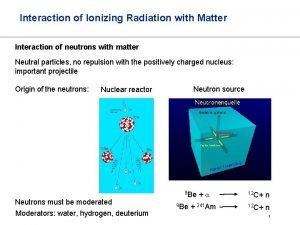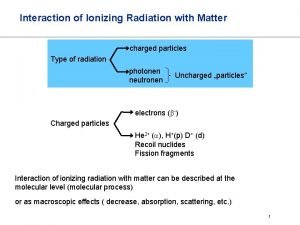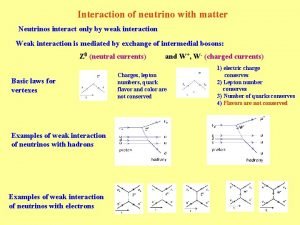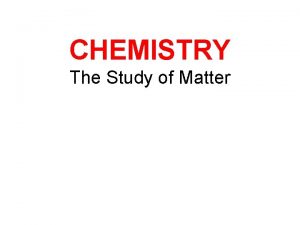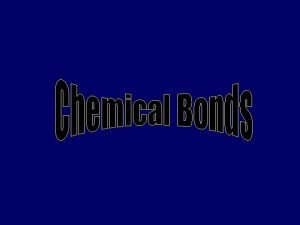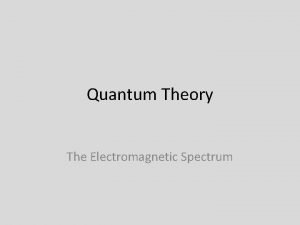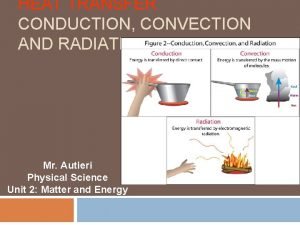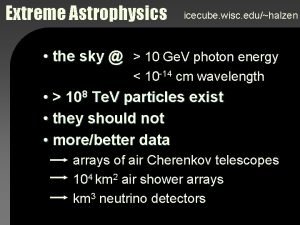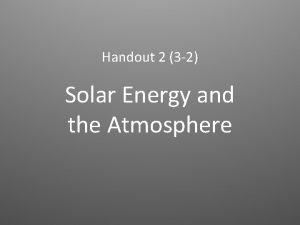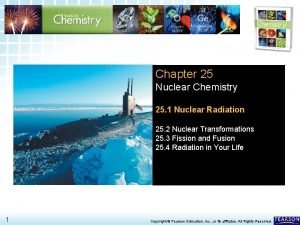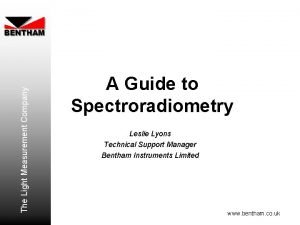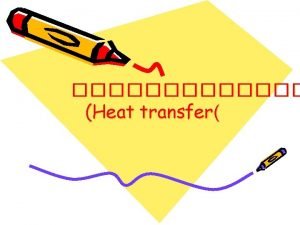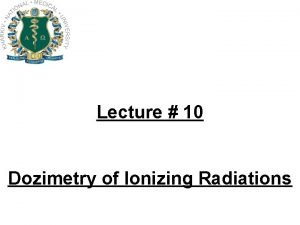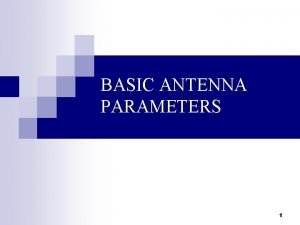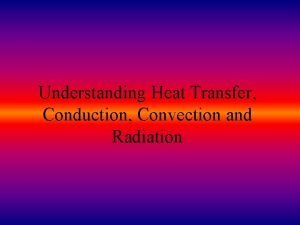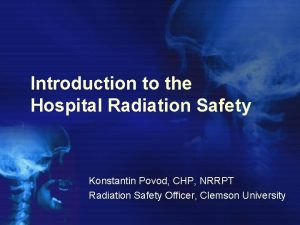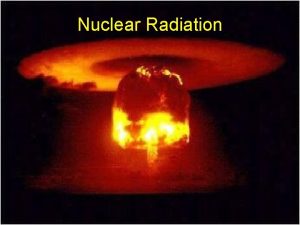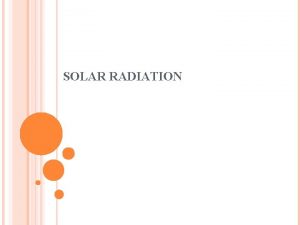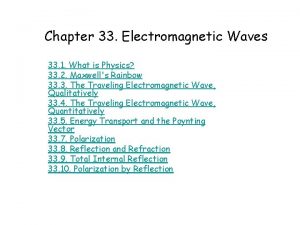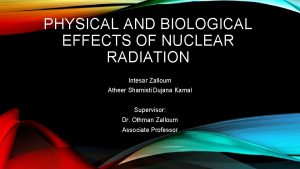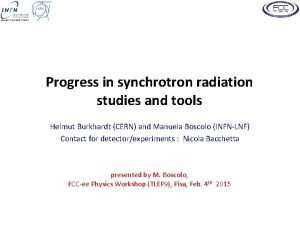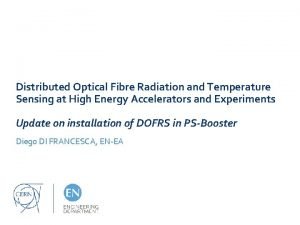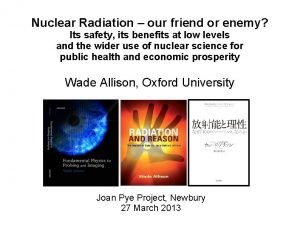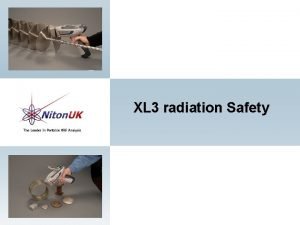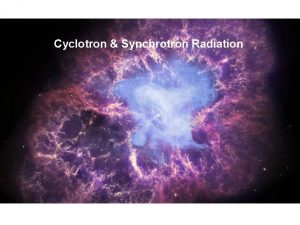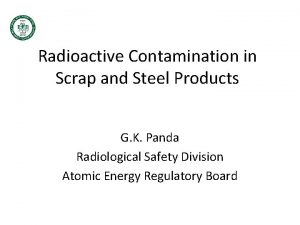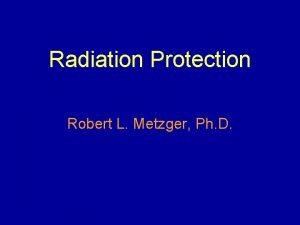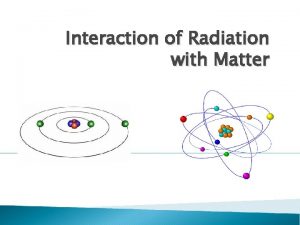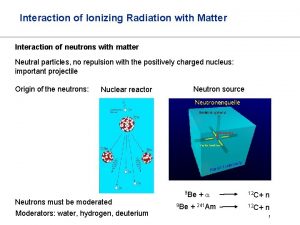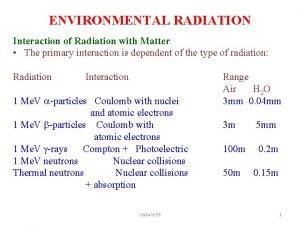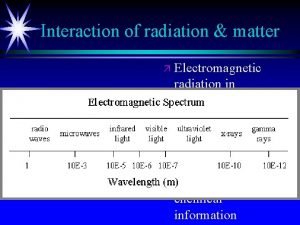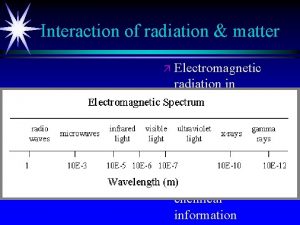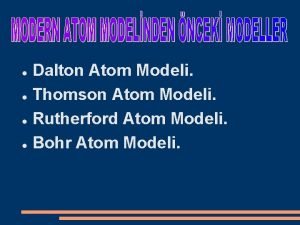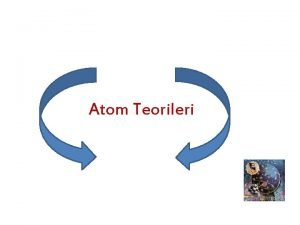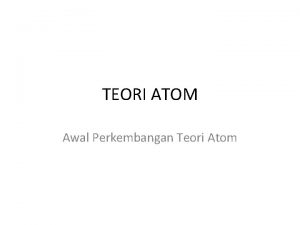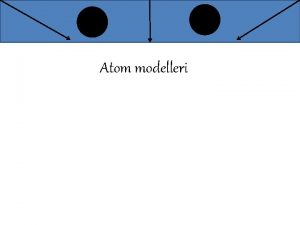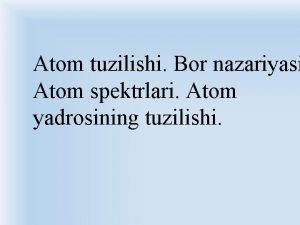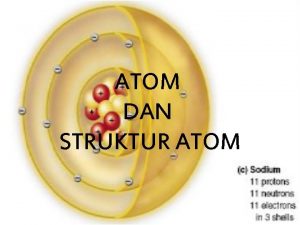Interaction of Radiation with Matter MATTER ATOM An













































- Slides: 45

Interaction of Radiation with Matter

MATTER

ATOM An Atom can be defined as the smallest quantity of an element which can enter into a chemical reaction. All atoms of a particular element are chemically alike but they differ from the atoms of other elements. The atom is a basic unit of matter.

BASIC MODEL OF ATOM Electrons(-) orbiting nucleus of protons(+) and neutrons. Same number of electrons as protons; net charge = 0. Atomic number (number of protons) determines element. Mass number (protons + neutrons) gives mass in terms of 1/12 th mass of Carbon atom.


ELEMENT An Element is a substance which cannot be split up into two or more simpler substances by the usual chemical methods of applying Heat, Light or electric energy. An is made up of atoms. All having same atomic number.

RADIATION Radiation is an energy in the form of electro-magnetic waves or particulate matter, traveling in the air. OR The term radiation applies to the emission and propagation of energy through space or a material. Types of Radiation Ionizing Non- Ionizing

Basic Concept of Interaction Three possible occurrences when x or gamma photons in the primary beam pass through matter: ◦ No interaction at all Known as transmission ◦ Absorption ◦ Scatter The latter two are methods of attenuation

NUCLEAR INTERACTION Forces: There are many interactions among nuclei. It turns out that there are forces other than the electromagnetic force and the gravitational force which govern the interactions among nuclei. Einstein in 1905 m showed 2 more laws: energy/mass, and binding energy

IONIZATION RADIATION • Electromagnetic • Particular X-rays (produced extra-nuclearly) γ-rays (produced intra-nuclearly) Electrons Protons α-Particles Neutrons Deuterons Heavy charged particles

ELECTRMAGNETIC SPECTRUM The electromagnetic spectrum is the range of all possible frequencies of electromagnetic radiation. The "electromagnetic spectrum" of an object has a different meaning, and is instead the characteristic distribution of electromagnetic radiation emitted or absorbed by that particular object.

Like X-rays, radio waves, radar, radiant heat, laser and visible light are forms of electromagnetic radiation. They have the same velocity but different wavelengths. For example, radio wave have a wavelength of 300 m; visible light - 5 x 10 -5; X-rays - 1 x 108 cm.

ELECTRMAGNETIC SPECTRUM An

Electromagnetic Spectrum

Electromagnetic Spectrum

ELECTRMAGNETIC RADIATION Electromagnetic radiation (EM radiation or EMR) is a form of energy emitted and absorbed by charged particles which exhibits wave-like behavior as it travels through space. EMR has both electric and magnetic field components. In a vacuum, electromagnetic radiation propagates at a characteristic speed, the speed of light.

General Characteristics of EMR no mass or physical form travel at speed of light (c) in a vacuum (or air) c = 3 x 108 m/s travel in a linear path (until interaction unaffected by occurs) electric or magnetic fields gravity

Contd… obeys the wave equation c = In Passing through the matter, the intensity is reduced (attenuation), because of absorption & scattering. obeys the inverse square law I 1 d 1 2 = I 2 d 2 2 Radiation intensity is inversely proportional to the square of the distance from the source at any place.

Contd…. In passing through matter, the intensity of the radiation is reduced (attenuation), both because some radiation energy is taken Up by material (absorption) and some is deflected from its original path to travel in a new direction (scattering). It should be noted that any effect of radiation on matter depends on how much energy that matter receives (absorbs) from the beam

Types of Radiations Two types of Radiation: ◦ Ionizing Radiation ◦ Non-ionizing Radiation

IONIZING RADIATION Ionizing radiation is produced by unstable atoms. Unstable atoms differ from stable atoms because they have an excess of energy or mass or both. Unstable atoms are said to be radioactive. In order to reach stability, these atoms give off, or emit, the excess energy or mass. These emissions are called radiation.

NON-IONIZING RADIATION They are electromagnetic waves incapable of producing ions while passing through matter, due to their lower energy. ” It has not enough energy to pull electron from orbit, but can excite the electro.

NON-IONIZING Vs IONIZING Radiation that has enough energy to move atoms to vibrate, but not enough energy to remove electrons. The process by which a neutral atom acquires a positive or a negative charge is known as Ionization. Removal of an orbital electron leaves the atom positively charged, resulting in an ion pair. • molecule with a net positive charge • free electron with a negative charge

Primary Types of Ionizing Radiation Alpha Particles Beta Particles Gamma Rays (or Photons) X-Rays Neutrons

Radioactive Atom Ionizing Radiation alpha particle X-ray beta particle gamma ray

ALPHA PARTICLES Alpha Particles: emitted from the nucleus of an atom have 2 neutrons and 2 protons They travel short distances, have large mass. It is identical to the nucleus of a Helium atom, without the electrons. Only a hazard when inhaled.

BETA PARTICLES Beta Particles: Electrons or positrons having small mass and variable energy. Emitted from the nucleus of an atom. Electrons form when a neutron transforms into a proton and an electron.

GAMMA RAYS Gamma Rays (or photons): are Electromagnetic waves / photons. Releases energy, usually after an alpha, beta or positron transition Emitted from the nucleus (center) of an atom. Have higher energy in Me. V’s.

PENETRATION POWER

X-RAYS X-Rays: are photons Electromagnetic waves and photons. Emitted from electron orbits. X-rays have energy in Ke. V‘s.

The Five Interactions Of X and Gamma Rays With Matter Photoelectric Effect Compton Scatter Coherent Scatter Pair Production Photodisintegration ◦ Very important in diagnostic radiology ◦ Not important in diagnostic or therapeutic radiology ◦ Very important in therapeutic radiology

Photoelectric Effect All of the energy of the incoming photon is totally transferred to the atom. ◦ Following interaction, the photon ceases to exist The incoming photon interacts with an orbital electron in an inner shell – usually K. The orbital electron is dislodged. To dislodge the electron, the energy of the incoming photon must be equal to, or greater than the electron’s energy. The incoming photon gives up all its energy, and ceases to exist.

Cont… The ejected electron is now a photoelectron. This photoelectron now contains the energy of the incoming photon minus the binding energy of the electron shell. This photoelectron can interact with other atoms until all its energy is spent. These interactions result in increased patient dose, contributing to biological damage. A vacancy now exists in the inner shell. To fill this gap, an electron from an outer shell drops down to fill the gap.

Cont… Once the gap is filled, the electron releases its energy in the form of a characteristic photon. This process continues, with each electron emitting characteristic photons, until the atom is stable. The characteristic photon produces relatively low energies and is generally absorbed in tissue. In diagnostic radiology, the primary mode of interaction is photoelectric. It is also responsible for the contrast effect. In therapeutic radiology, low-energy beams in orthovoltage irradiation caused excessive absorption of energy in bone.

Cont…

Compton Effect An incoming photon is partially absorbed in an outer shell electron. The electron absorbs enough energy to break the binding energy, and is ejected. The ejected electron is now a Compton electron. Not much energy is needed to eject an electron from an outer shell The incoming photon, continues on a different path with less energy as scattered radiation. The Compton effect results in both attenuation and absorption.

Cont… The attenuation caused here is dependent upon the Electron density and is practically same for all substances except hydrogenous material, like water and soft tissue, where the Compton effect is greater (because of the higher electron density). It does not depend on Atomic Number. It is measured as mass scattering coefficient (σ/ρ),

Cont…

Coherent Scatter Occurs at low energies – below 30 k. Vp. An incoming photon interacts with an atom. The atom vibrates momentarily. Energy is released in the form of an electromagnetic wave. A combination of these waves form a scatter wave. The photon changes its direction, but no energy is transferred. May result in radiographic film fog.

Pair Production Does not occur in the diagnostic energy range. Incoming photon must have an energy of at least 1. 02 Me. V. This process is a conversion of energy into matter and then matter back into energy. Two electrons are produced in this interaction. An incoming photon of 1. 02 Me. V or greater interacts with the nucleus of an atom. The incoming photon disappears.

Cont… The transformation of energy results in the formation of two particles Negatron Positron ◦ Possesses negative charge ◦ Possesses a positive charge. The produced gamma photons may interact with matter through pair production or Compton scatter. Pair production is used for positron emission tomography, a nuclear medicine imaging procedure. It is also used in radiation therapy

Pair Production: When the photon with energy in excess of 1. 02 Me. V passes close to the nucleus of an atom, the photon disappears, and a positron and an electron appear. Annihilation: These two particles collide, converting to 2 photons with equal energy of 511 kev.

Photodisintegration Occurs at above 10 Me. V. A high energy photon is absorbed by the nucleus. The nucleus becomes excited and becomes radioactive. To become stable, the nucleus emits negatrons, protons, alpha particles, clusters of fragments, or gamma rays. These high energy photons are found in radiation therapy.


 What is interaction of radiation with matter
What is interaction of radiation with matter Ionizing radiation
Ionizing radiation The structure of the atom section 2 defining the atom
The structure of the atom section 2 defining the atom Kelemahan teori atom rutherford
Kelemahan teori atom rutherford Neutrino interaction with matter
Neutrino interaction with matter Study of matter
Study of matter The smallest unit of an element
The smallest unit of an element Gray matter and white matter
Gray matter and white matter Chapter 2 matter section 1 classifying matter answer key
Chapter 2 matter section 1 classifying matter answer key Flow of energy vs flow of matter
Flow of energy vs flow of matter Pallium telencephalon
Pallium telencephalon Classification of matter section 1 composition of matter
Classification of matter section 1 composition of matter What makes up the diencephalon
What makes up the diencephalon Grey matter of nervous system
Grey matter of nervous system Composition of matter section 1
Composition of matter section 1 Composition of matter section 1
Composition of matter section 1 Electromagnetic wavelength formula
Electromagnetic wavelength formula Identify heat transfer shown in each picture
Identify heat transfer shown in each picture Cherenkov radiation
Cherenkov radiation Solar radiation
Solar radiation Types of radiation
Types of radiation Types of rhythm in fashion design
Types of rhythm in fashion design Define radiation intensity
Define radiation intensity What is heat transfer conduction convection and radiation
What is heat transfer conduction convection and radiation Conduction convection radiation equations
Conduction convection radiation equations Radiation dose limits
Radiation dose limits Ionizing radiation
Ionizing radiation Radian and steradian in antenna
Radian and steradian in antenna Which is the best surface for reflecting heat radiation
Which is the best surface for reflecting heat radiation Remnant radiation
Remnant radiation Cherenkov radiation
Cherenkov radiation Nuclear radiation
Nuclear radiation Solar radiation
Solar radiation Intensity of electromagnetic wave
Intensity of electromagnetic wave Hse radiation registration
Hse radiation registration Cherenkov radiation
Cherenkov radiation What is nuclear radiation
What is nuclear radiation Synchrotron radiation
Synchrotron radiation Dofrs
Dofrs For parents and friends radiation threat
For parents and friends radiation threat Radiation safety
Radiation safety Cyclotron and synchrotron radiation
Cyclotron and synchrotron radiation Weighbridge radiation detector
Weighbridge radiation detector Ufc 3-535-01
Ufc 3-535-01 Rhythm transition
Rhythm transition Ionizing radiation sources
Ionizing radiation sources
